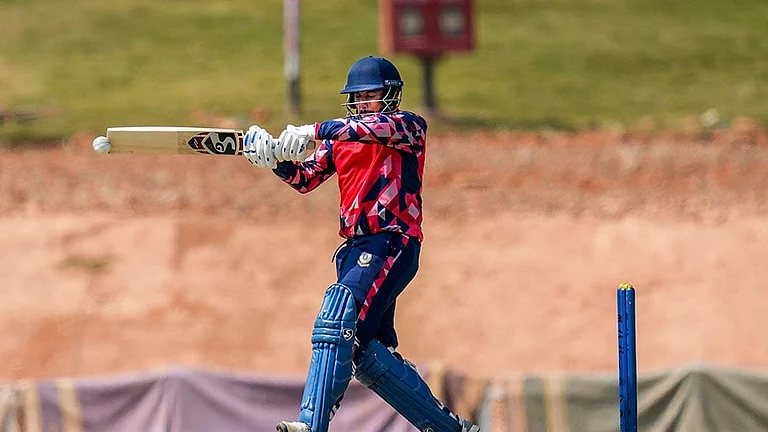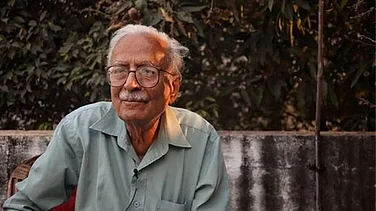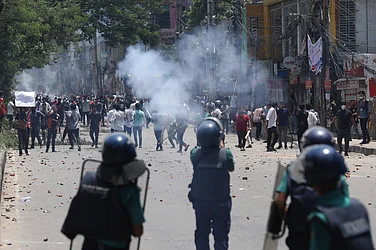The tunnel was that kind of place where hope disappeared. Just like the sunshine had. Always a place of the poor, of those who know the risks and yet, they sign up for the job. Like the 41 workers did. It is a story of migration and of the different universes people inhabit, like the construction workers did.
Outside, people kept a vigil. Family and rescue workers. On television and other media, we kept the vigil too.
Most were in their 20s. In the claustrophobic rubble, they must have oscillated between the past and the future. The present was darkness. They had each other. And they had cards that they had made out of paper. A deck of cards to perhaps play the game of fate, to give them a sense of hope in a piece of paper masquerading as a card. To perhaps not think about what if nobody would come for them or if they wouldn’t manage to pull them out. They kept death at bay. Somehow. With cards, Ludo, and each other. Was there hope then? They didn’t know but maybe didn’t want to talk about despair either.
Anil Bedia from Khairabera village near Ranchi was the first worker to be rescued on November 28. But when he was trapped inside, especially during the first couple of days, there was fear and uncertainty. There was absolutely no contact with the outside world. But he was ingenious enough to create a deck of cards by just tracing designs and numbers on pieces of paper.
A deck of playing cards was also a means of solace for the 33 miners trapped after a tunnel in the San Jose gold and copper mine collapsed in 2010 in Chile’s Atacama region. Buried 700 metres deep, some of the miners lost 22 pounds in bodyweight during the ordeal, before they were rescued after 69 days.
Playing cards also defined the fate of Rana, a trapped coal miner played by Mac Mohan in Yash Chopra’s Kaala Patthar. Suspected as a cardsharp, Rana purposely draws a low card from a deck, sacrificing an opportunity to be rescued at the very end in favour of a fellow miner, just before the chunks of coal and a barrage of water bury him in the film.

For Bedia and other workers, the cards served as a way to pass the time while they waited for fate to deal them their hand. The rest of the time, he and his co-workers walked around in the tunnel. Tiredness and sheer fatigue put them to sleep often. Sometimes, they played Ludo, another game of chance that originated in India and was known as Pachisi, where the roll of cowrie shells defined the moves. “We would chit-chat or play Ludo to kill time. On some days, we would take walks to stretch our legs,” says Chamra Oraon, who is from Karra block in Jharkhand.
A Hero is Born
In the unceasing war between man and nature, 41 brave workers—trapped for 400 hours under 60 metres of debris—on November 28 won one battle. The battle of sheer survival against odds.
Soon after loose debris and freshly pulverised rocks locked them in a stony, seemingly unreachable womb within the Himalayas, a hero emerged in the form of ‘Gabbar Singh’ Negi.
As the story of this ‘Gabbar Singh’ is recounted over time, it may subtly contribute to transforming the recall of his Sholay namesake dacoit from a symbol of villainy to a beacon of courage.
The foreman’s calm, reassuring words soon after the calamity had earned him the role of a leader of the group of 40.
At 51, Gabbar Singh from Pauri Garhwal had spent half his life underground, helping bore tunnels in Sikkim, Himachal Pradesh, Arunachal Pradesh, and his own state, Uttarakhand.
Buried deep in the cold cavern at the under-construction Silkyara–Barkot tunnel, he took charge from day one of the ordeal, breathing warm hope in the anxious hearts of his fellow crew.
To his men, Gabbar Singh made a solemn promise; that he would be the last to exit the tunnel whenever a rescue operation commences.
Gabbar Singh kept his word. He was the last tunneler to surface on November 28, when rescue teams, after hundreds of hours of collective effort, managed the much-awaited breakthrough as the nation waited with bated breath.
In the age of 5G connectivity, a six-inch metal pipe served as the only means of communication between the trapped men, their worried kin and a desperate administration.
“I am fine inside the tunnel. So go back home and take care of your mother and grandmother (a widow). I am not alone here. I have a strong 41-member family with me, but your mother and grandmother are lonely at home,” Gabbar Singh had told his son Akash, after repeated rescue attempts failed.
Twenty-eight-year-old Sabah Ahmed from Bihar was the other motivator for his fellow trapped workers, “engaging them in lighter conversations and board games”. Negi and Ahmed also got their colleagues to perform yoga, regular walks and meditation to stop their spirits from flagging in the confined space, which severely limited hope. “They (Gabbar and Sabah) became our natural team leaders in those agonising moments,” said Jai Prakesh, after his rescue.

Tunnel Trauma
Gabbar Singh’s calm was critical to young tunnelers like 20-year-old Vishal Singh from neighbouring Himachal Pradesh. His family rears goats in Bagot village in Mandi district and one of their possessions is a photograph of their lanky lad wearing a black sleeveless t-shirt with the word ‘Dangerous’ embossed in red on it.
“The initial two-three days were very tough and traumatic,” he says. Trapped in the space with no assurances or access to the outside world, the workers lived off spring water coursing over rocks, moistening their tongues and nourishing hope. That’s before the rescuers managed to send across food, drink and medicine to them through the metal pipe. “Once rescuers started sending some eatables, water and medicines, we got assured that nothing worse would happen to us. They (authorities) also kept boosting our morale,” he said.
On the surface, multiple government agencies like the Indian Army, disaster response forces from the state and the centre, police and health services scampered to dig deeper without endangering the trapped lives below.
Mountains in Malady
Deep underground, the workers who slugged away at the site of the 4.5 km-long Silkyara-Barkot tunnel, a part of Prime Minister Narendra Modi’s ambitious Char Dham project—a $1.5 billion national infrastructure initiative to enhance connectivity to the Hindu pilgrimage sites of Badrinath, Kedarnath, Gangotri, and Yamunotri—too were drawn from different religions and different parts of India. Many of them hail from Jharkhand.
Environmentalists have repeatedly voiced concerns about the long-term ecological consequences of the extensive Char Dham project, as well as the tunnelling, particularly in the wake of recurring disasters such as the tragedies in Chamoli, Joshimath and Kedarnath.
These events have intensified scrutiny of large-scale infrastructure projects, prompting calls for rigorous environmental impact assessments. According to recent reports, experts emphasise the need for sustainable development practices and heightened awareness of the potential ecological ramifications associated with ambitious initiatives in the fragile Himalayan region. Such considerations are crucial for mitigating risks and preserving the delicate ecosystem.

The Jharkhand Contingent
For Chamra Oraon, the first couple of days in the caved-in hollow were scary because loose debris would keep falling indiscriminately on them as the hillside temporarily stabilised after the November 12 collapse.
“The first two to three days after the tunnel collapse were scary because loose debris kept falling. Initially, we were anxious, but after some time passed, we were hopeful,” he said. The cavern was around two kilometres in length and the trapped men would often take walks in the space in teams.
Far away in Jharkhand’s Gumdu village, a phone rang in the Horo household on November 28 at around 8 PM. When Sanarti Horo picked it up, it was her husband, 21-year-old Vijay. There was relief in his voice. He had managed to establish contact with his family after 400 long hours. Sanarti was relieved too.
“It was a short call. He informed me that he was well. They were all in an ambulance, being taken to a hospital. I was so relieved to hear his voice. His parents got emotional and started crying. I am so glad that all of them are safe,” she said.
For the Horo family— his parents, four siblings and wife—the last few days were like a bad dream. His 10-month-old child is too young to understand the kind of havoc that 400-plus hours of absence of a loved one can wreak on a family.
But after the rescue, the family watched the updates on their mobile screens amid fluctuating network—something they had avoided doing so far. Their neighbours came over to congratulate them. Sweets were distributed. The family is now waiting for him to come back. When asked if they would let Horo go back to Uttarakhand, his wife said: “No”.
Despite the large-scale migration from one of India’s newer states, government data on the subject is not accurate. The Jharkhand government started head-counting its migrant workers for the first time when they arrived in large numbers during the lockdowns.
If the official numbers are to be believed, there are approximately one million migrant labourers from Jharkhand working in various parts of the country. The number of labourers registered on the government’s e-Shram portal is more than 1.11 crore.
Most of these labourers work in the unorganised sector and don’t get benefits like Provident Fund (PF) or a fixed monthly honorarium. Earlier, the migration pattern was largely cyclic and labourers would return for the paddy sowing season. But the severe and recurrent droughts—10 in 22 years—due to climate change have impacted farming, which is largely rain-fed. The irrigation capacity in Jharkhand is only 32 per cent. So now, even those who are into farming are forced to migrate. Large-scale unemployment and poverty are other reasons for migration.
According to NITI Aayog’s Multidimensional Poverty Index, Jharkhand is the second-poorest state in the country, with a poverty level of around 42.2 per cent. According to the Centre for Monitoring Indian Economy (CMIE) data released in December 2021, Jharkhand ranked third with 17.1 per cent unemployment. As per the report released in March this year, unemployment has gone up to 17.6 per cent. Ironically, Jharkhand accounts for nearly 40 per cent of the country’s mineral wealth. But the state’s male workforce, men like Anil Bedia, Sukram Bedia and Rajendra Bedia, work as labourers in outstation projects like the one which went under in November.
The three men from the Bedia clan are from Khairabera village in Chuttapalu Panchayat of Ormanjhi block, thirty kms from Ranchi. Twelve boys from the village had migrated to Uttarakhand in hope of livelihood. Three ended up being trapped in the tunnel.

Swati Narayan, a Right to Food campaign activist, believes that the very low per capita income and minimum wages in MNREGA are primary reasons for migration. “When wages are low, people will go to other places where they get good money. The MNREGA wages are one of the lowest in Jharkhand. Work is not available regularly and money for work also comes very late. During Covid, the government had promised the migrant labourers that they would be provided jobs in the state so that they wouldn’t have to go out. But these promises were insufficient,” she says.
A majority of the workers trapped under the earth were from Jharkhand (15). Eight hailed from Uttar Pradesh, five each from Odisha and Bihar, three from West Bengal, two each from Uttarakhand and Assam, and one from Himachal Pradesh.
Most of these workers migrated from India’s economically disadvantaged states in search of employment opportunities, given the scarcity of work in their native villages. For these families, the struggle extends beyond securing two meals a day, encompassing challenges such as access to safe water, durable housing, electricity, medical care, and education.
Former deputy mayor of Shimla, Tikender Panwar, a specialist in labour rights, underscores the commonality among these trapped men, originating from impoverished backgrounds and families. “They may be men from different states, but the fact of the matter is that each one of them comes from very poor backgrounds and families. It’s livelihood that has brought them to Uttarkashi to perform one of the challenging tasks,” according to Panwar, who is also a labour rights specialist.
Hope Through a Pipe
The first real food that poured in through the pipe that provided them with access to the outside world was puffed rice and chana.
“Then slowly, they start passing on food packets. We would get water through pipes,” Oraon said. The pipes emptied out portions of rice, paneer, rotis as well as the necessary medical supplies for the trapped men.
The pipes helped the administration send in mobile phones and portable chargers too, enabling communication with the rescuers and kith, kin.
“I managed to speak to my family once. I spoke to my wife and youngest daughter. She asked about my whereabouts and told me to come home soon. That gave me hope. After the rescue, I spoke to my family twice,” Oraon said. His mother cried upon hearing his voice.
Ganpati Horo, another worker from Jharkhand, preferred to play games on his mobile. “I would play games on my mobile to kill time. We could charge our phones as they had passed on chargers through the pipes,” he says. Amid tapping his phone screen and navigating its glare, visions of his mother seared his soul. He was unable to speak to his mother, because she is hard of hearing.
But the country was already tuning into the fate of the 41 men, whose lives had plunged into uncertain darkness after the portion of under-ground tunnel collapsed on November 12, Diwali.
Failures
Numerous rescue efforts started by the National Highway and Infrastructure Development Corporation Ltd (NHIDCL) with the help of several experts, both from India and abroad, had been underway. There were major setbacks and technical challenges along the course of the rescue operation.
Even a US-made giant Auger machine deployed to drill an escape channel through 60 metres of debris broke down after drilling 45 meters. Efforts to repair the damaged monster machine failed, leaving the administration no choice but to explore other options.
Rat-Miners to the Rescue
Conventional methods had failed, as had behemothic gadgets, like the giant American drill. Logistics and emotion appeared to have failed too. What really helped the rescuers get a breakthrough was resorting to a banned practice.
Rat-hole mining, a contentious technique for extracting coal from narrow, horizontal mines, involves miners excavating pits barely spacious enough for a single person to descend and retrieve coal. Frequently conducted without adequate safety measures or ventilation, these excavations pose significant risks. Recognising the environmental and safety concerns associated with this practice, the National Green Tribunal (NGT) took decisive action in 2014 by imposing a ban on rat-hole mining in India.
Human rights groups have claimed that nearly 10,000 to 15,000 persons working as rat-hole miners have died in such operations between 2007 and 2014, just before the ban. However, some of the miners in the rescue operation said they got their training in Delhi and were not coal miners.
Before the practice was banned, rat-hole miners typically dug out coal from the mines by digging small tunnels, usually three to four feet deep, like rats burrowing in the ground. The miners lacked safety gear, extracting coal manually with rudimentary tools. The practice, harmful to the environment, is associated with soil erosion, deforestation, river acidification and disruption of ecosystems, according to experts. This time, the brief given to the rat-hole miners though was to extract the trapped, anxious men, and not swing a pick at fossilised, inanimate carbon.
On November 27, a team of 24 rat-hole miners had gone into what seemed like an abyss of despair through their only gateway, an 800 mm pipe laid through rubble, armed only with small tools and drills. They created a narrow passageway, persistently chipping away at the remaining 10-12 metres of debris, inching towards the trapped men, finally managing to establish contact with the trapped workers inside. The last-ditch effort worked wonders. Each trapped worker was pulled out individually and strapped to a wheeled stretcher.
Munna was one of the rat-hole miners, who broke through first.
“It was a difficult task and challenging too. Since it was a question of saving the lives of our mazdoor brothers, we did not care much. Once we reached out to them after clearing the debris, I saw tears in their eyes. They hugged us profusely”.
Breakthrough
The first breakthrough came around 7.15 PM on November 28, after which the NDRF and SDRF teams entered the tunnel and started the process of evacuation. Outside the tunnel, ambulances were kept in readiness to shift the workers to a hospital.
“It’s a great thing none of the 41 men was injured, hurt or weak. All have come alive, warm and healthy. This is the beauty of the operation, which was the most challenging. It had setbacks, yet we kept going. Everyone contributed their best and this made the operation different in the world,” maintains Arnold Dix, a globally acclaimed tunnel expert who was involved in the rescue operation. It was the Australian who had first suggested the use of rat-hole mining, as a viable option.
At the earliest sign of the rescue being successful and the extraction of the workers, many in the large crowd that had assembled at the tunnel site, lit fire crackers, distributed sweets and cheered up visibly relieved families.
While their kin trapped underneath, anxious family members camped on the surface. Some had rushed to the site soon after they heard about the incident and did not budge for 15-16 days.
When Gabbar Singh kept his promise and exited after his other 40 men had surfaced, his brother Jaimal, likened their meeting to ‘Bharat Milap’ – the reuniting of the banished deity Lord Ram with his brother Bharat.
“Just see the warmth in the air today. It’s freezing cold, yet everyone is cheerful and rejoicing. Trees are singing songs in jubilation and mountains are cheering the victory of life. Our 41 brave shramaveer (The workers were greeted with garlands and sweets inside the tunnel, as many found themselves overwhelmed by emotions and only responded with folded hands.
Chaudhary, father of worker Manjit from Bihar, who the country would know as the anxious man sitting in the face of the tunnel during the rescue operation, said he would never let his son return to Uttarakhand. “I will take my son back home. People in my village are also waiting to join in the celebrations. It’s second birth for Manjit,” Chaudhary said.
For the waiting Rajni Kisku from Banka district in Bihar, the successful rescue operation was a big moment. A mother of four children, including four daughters, she had been camping at the tunnel site for the past 14 days, along with her brother-in-law.
“It is a big day for me,” she said. Rajni, who had resolved not to return home without her husband, Virender, believes her prayers were answered, when she saw her husband alive.
The near-tragedy has had its consequences. The government has ordered a social audit of all under-construction tunnels, a dozen of which are in the Himalayan region.
And for many migrant workers like Chamra Oraon from Karra block in Jharkhand, the scars of spending more than 400 hours trapped underground, has made him rethink a return to the Dev Bhoomi. “My wife is relieved. My mother got emotional and started crying. I can’t wait to get back home and meet my family. Once I am with them, I will discuss my future and together we will take a call on whether I would be coming back to Uttarakhand,” he said.
Ashwani Sharma, Md Asghar Khan & Shailendra Godiyal
(Shailendra Godiyal is an Uttarakhand-based journalist)



























